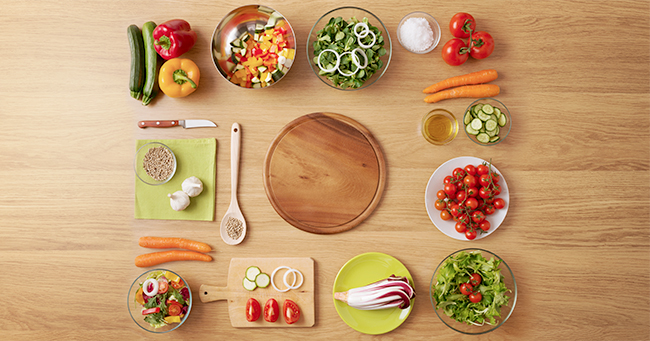Vegetarian Diets
People choose vegetarian diets for a variety of reasons including health, social, ethical, environmental, religious, or other factors. Nutritionally adequate vegetarian styles of eating are supported by scientific literature as healthful and beneficial in the treatment and prevention of certain chronic diseases. Also, vegetarian diets are found to be appropriate for individuals during all stages of life including infancy, childhood and adolescence, during pregnancy and lactation, and for athletes. As more people turn to this diet, more vegetarian foods, including vegetarian and vegan fiber bars, become available. This article explains some of the basic elements of vegetarian diets, nutritional considerations and practical tips.
Vegetarian Basics
There are different types of vegetarians. Broadly speaking, someone who calls himself or herself “vegetarian” does not eat meat, fish, or poultry, or byproducts of these items. The different types of vegetarian diets include:
Semi-vegetarian: A semi-vegetarian is someone who eats animal flesh on an occasional basis. Pollo vegetarian – someone who avoids red meat and fish but eats chicken, and pesco pollo vegetarian – someone who avoids red meat but eats chicken and fish, are alternative names for semi-vegetarians.
Lacto-ovo vegetarian: The most common, lacto-ovo vegetarians exclude fish, meat, and poultry, but enjoy cheese, milk, yogurt, eggs, and other diary products.
Lacto vegetarian: All dairy foods are considered acceptable to lacto vegetarians while eggs are excluded.
Vegan: A vegan avoids eating ALL animal products – meat, fish, poultry, dairy, eggs, honey, and any foods that contain by-products of these items. Vegans may also avoid using non-food items made with animal by-products, such as leather, wool, and silk. Vegan protein and fiber bars are made without these ingredients.
Health and Nutritional Considerations
Because vegetarian diets prioritize fruits, vegetables and whole grains, they are an excellent source of fiber and antioxidants, and are associated with several health advantages, including, lower blood pressure and cholesterol levels, lower risk of heart disease and type 2 diabetes, and healthier weight. In addition, there are key nutrients for vegetarians to attend to.
Protein – Protein needs can be met by eating a variety of plant foods. Vegetarian protein sources include beans and peas, nuts, and soy foods such as tofu and tempeh – which are all good fiber sources. Vegan protein bars typically use soy protein. Just two servings per day are needed and combinations of foods are not necessary to satisfy protein needs. Dairy foods and eggs are good protein sources for lacto-ovo vegetarians.
Calcium – Calcium is important at all stages of life, especially during childhood and adolescence. With three good sources per day – cow’s milk and other dairy products, calcium-fortified soymilk and orange juice, leafy green vegetables like kale and collards, and tofu processed with calcium sulfate can give vegetarians what they need.
Iron – Iron from plant foods is not as well absorbed by the body as iron from meat sources. However, vitamin C-rich foods (i.e., citrus fruits and juices, tomatoes) eaten in conjunction with these iron-containing foods can help to increase their absorption.
Vitamin B12 – Since vitamin B12 is only found in animal foods, vegans should pay special attention to this nutrient. Choose fortified foods such as cereal or soy products, or take a vitamin B12 supplement – the amount offered in a multivitamin is also considered adequate.
Omega-3 fatty acids – Vegetarian diets may be marginal in omega-3 fatty acids, especially those that do not contain fish or eggs. Since omega-3s are important for cardiovascular health, and eye and brain development, vegetarians should include plant-based sources such as flaxseed, walnuts, canola oil, and soy.
Practical Tips
A vegetarian diet can be healthy at any age, and doesn’t have to be complex. With beans and legumes, nuts, nut butters and seeds, fruits, leafy greens and other vegetables, and whole grains, nutritional needs are met.
- Many popular dishes are already, or can be made vegetarian with the replacement of animal protein – bean burritos and soups, vegetable lasagna, and hummus and veggie wraps are just a few examples.
- Replace chicken with beans on a salad, or beef with tofu in stir-fries.
- Make grilled or roasted vegetables the centerpiece of meals, and add vegetarian sources of protein and whole grains as a compliment.
- Vegan protein and fiber bars are and fast and easy choice for maintaining a vegetarian lifestyle on the go.
Reference: Academy of Nutrition and Dietetics Position Paper on Vegetarian Diets, 2009.
Anne Marie Kuchera, MS, MA, RD, LPC is a registered dietitian, and both a licensed nutritionist and licensed professional counselor. She manages community-based obesity prevention and preventive health and wellness initiatives through Children’s Hospital of Pittsburgh of UPMC.


